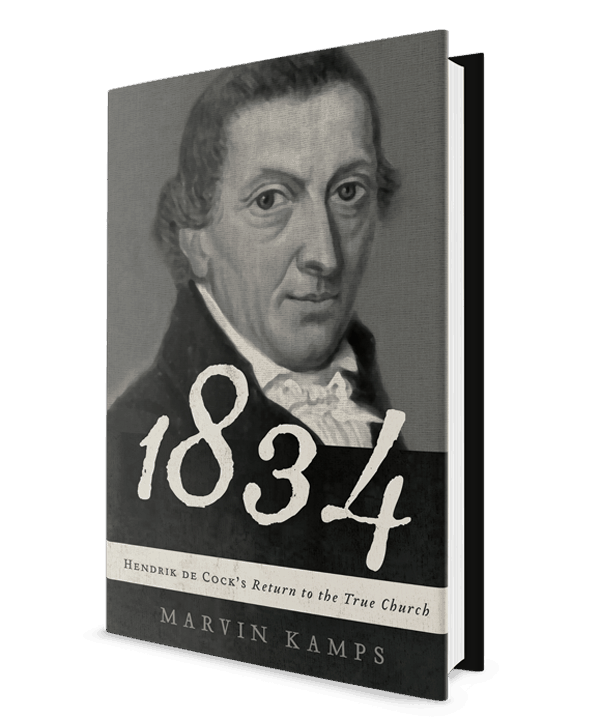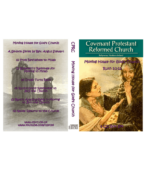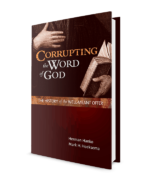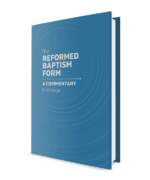The author’s narrative recounts the reformation of the church in 1834, when Hendrik de Cock witnessed against the false doctrines and unspiritual character of the state Reformed church of the Netherlands. After having been unceremoniously suspended and deposed from office, he led his congregation to return to the biblical worship of God in Christ Jesus as set forth in the Reformed creeds, which represents the faith of God’s saints throughout the ages. His courageous testimony has inspired the witness of hundreds of thousands of people throughout the world until this day.
This book therefore recounts one man’s struggle against the perversions of Scripture by the vast majority of ordained pastors in the state Reformed church with its million or more spiritually sleeping members. Contra mundum was the character of this struggle for the truth. De Cock’s witness therefore was a trumpet blast in the night of spiritual darkness that awakened God’s people at the morn of a new day, while at the same time it angered and galvanized the unfaithful ecclesiastical administrators in opposition. De Cock gave witness to the sole authority of sacred Scripture and to the binding authority of the Reformed creeds, which for Reformed believers is derived from the binding authority of the Bible.
“If first impressions count for anything, this book is a winner from the start. It has a sharp, handsome look and feel. From front to back, it’s been professionally produced and that made this reviewer favorably inclined from the start. The Reformed Free Publishing Association has done justice to the subject by packaging this substantial volume with great care. The subject is a compelling figure from our Reformed church history in the Netherlands: Rev. Hendrik de Cock. He was a leader in the Secession (or ‘Afscheiding’ in Dutch) of 1834. The Lord worked through de Cock to recover the Reformed faith in the Netherlands after a period of great darkness and decline. This book traces his story in great detail. There is no other book like this in English—it is truly one of a kind … 1834 is a masterpiece of Reformed church history. Well-written and the product of countless hours of research, it was a delight to read” (Clarion and Una Sancta).
“This book will prove to be enjoyable for the average reader. It was written in a well-organized format and uses clear language which avoids highly academic terms. It is also illustrated with several pictures … The author explains the grounds for the Secession in a very carefully reasoned, but also a very sympathetic manner. Kamps defends his thesis as one who also takes very seriously the marks of the true and false church as confessed in the Belgic Confession (Art. 29). He demonstrates that these marks were central in the mind of Hendrik De Cock. The Secession was a reformational movement calling believers back to the Scriptures and thus returning to be a true church. The assertion that the Secession was intended as a return to the Scriptures has been readily defended by Kamps. As we see departures from Scripture characterizing some of today’s churches, this book is recommended to all students of our Reformed history who have a burden for Biblical faithfulness in our Reformed churches” (Messenger).
Prof. Engelsma: “This is a book about a spiritual hero. One day, God will honor him before all humans, especially before his contemptible enemies—ostensibly colleagues in a Reformed church—who persecuted him, and before the scarcely less contemptible ‘friends,’ who nevertheless refused to join him in his separation from the false church, which would have meant sharing his reproach—the reproach of Christ. The hero was an otherwise very ordinary preacher in the Reformed Church in the Netherlands in the early 1800s, Hendrik De Cock. His heroism was his lonely act of separating from the state Reformed Church, which had become apostate, and with his loyal congregation in Ulrum returning to the true church manifesting the marks of the true church as delineated in Article 29 of the Belgic Confession of Faith. Emphatically, as the instrument of the act declared and as the title of Kamps’ book expresses, the act of De Cock and his congregation was return, not only or even mainly separation, but return—return to the truth of the gospel, return to the true church, return to Christ Jesus the head of the church. This was the everlastingly worthy heroism of the reformation of the church in the Netherlands in 1834, as it is wherever and whenever reformation takes place. For this act of courage in the fear of God, a courage that despises the fear of man, the hero suffered greatly, as such heroes always do. He was fined, abused, and imprisoned by the state. He was maligned, disciplined, and deposed from office by the church. By all, he was defamed. By avowed friends in high places in the state church he was abandoned.”
“What a wonderful reference book to have. So glad the RFPA took this one on.” – Illinois, USA
“As I began to read this book, I must say that I increasingly looked forward to the time, after the house was quiet at night, when I could sit down and read it. Living in a world where good is called evil and evil is called good, where godliness of life and a sanctified walk are slandered, and where the place of the Reformed believer in this world gets smaller and smaller, it is good to sit down in the quiet of one’s home, close the door on the world and read an account of church history like this. The experience of Hendrik De Cock was the same as all faithful saints of God throughout church history who boldly and without compromise confessed the truth. It is encouraging to read of the mighty work of God in His despised and persecuted saints so that they are able to confess, ‘Blessed are they which are persecuted for righteousness’ sake: for theirs is the kingdom of heaven’ … There is one aspect of the book that I would like to emphasize in this review. It is the author’s insight into how false teachers and heresy soon come to dominate the church and how the false and apostatizing church works to threaten and intimidate the faithful into silence. This was the situation in De Cock’s day and whenever there is apostasy in the church. In contrast to this, the author points out the only way that God preserves to Himself a remnant that continues to confess the truth, and that is in the way of a sharp, uncompromising condemnation of the lie and a clear and zealous confession of the truth.” – Michigan, USA
BOOK REVIEW by Rev. Clayton Spronk
1834, the title of the book, is the year sixty-eight members of the Reformed congregation in Ulrum signed a document entitled Act of Secession or Return. By this act these Reformed believers separated themselves from the government sanctioned Reformed Church in the Netherlands and formed a new congregation that was (re)committed to the principles of the sixteenth-century Protestant Reformation. In the first 239 pages Marvin Kamps deftly explains and analyzes the events that resulted in faithful Reformed believers’ leaving a false church in order to begin a new true church of Jesus Christ. Kamps appropriately focuses on Hendrik de Cock, the pastor of the Ulrum congregation in 1834, whom God used almost singlehandedly to spark a momentous Reformation of the church commonly referred to as the Afscheiding in Dutch or Secession in English. The last 251 pages contain seven very valuable appendices, which would be worth purchasing and reading on their own. These appendices contain important historical documents that Kamps translated from Dutch into English.
The value of the first part of the book is that Kamps accurately explains the doctrinal significance of the Secession. In the preface Kamps explains that doctrine is his main concern. He writes, “In my recounting of the Secession of 1834 and the reformation of the Reformed church by Hendrik de Cock on the basis of the sole authority of the Bible, I will limit myself to the doctrinal issues of that reformation” (xvi). Because of this doctrinal concern Kamps does not focus on the historical question, how did the Secession come about? Rather the focus is on the weightier question, in what ways was the Session a true and necessary Reformation of the church of Jesus Christ? Kamps’ explanation is that the Secession was a true and necessary Reformation because it involved a rejection of false doctrine and a return to right doctrine as set forth in the Reformed confessions.
Kamps implies that his analysis of the issues involved in the Session is controversial. He writes, “The reformation of 1834 is often viewed superficially as a controversy about the “hymn question” and the error of baptizing children whose parents were not members of de Cock’s church in Ulrum” (152). Kamps recognizes that de Cock ran afoul of the state Reformed Church’s officials because he vehemently opposed the hymns that the state church adopted and because he agreed to baptize the children of parents who were not members of the Ulrum congregation. Kamps admits that these two actions contributed to the state church’s decision to discipline de Cock and finally depose him; and the deposition of De Cock eventually convinced members of the Ulrum congregation to secede from the state church in 1834. But Kamps rightly explains that the Secession involved other more central doctrinal issues than the “hymn question” and De Cock’s act of baptizing the children of parents who belonged to other congregations.
The Secession of 1834, Kamps explains, was a true and necessary Reformation because of the deep doctrinal division that developed between the state church and de Cock and his followers. The division was not the fault of de Cock. The division was the fault of the state church that for decades prior to 1834 allowed doctrines to be taught that contradicted the Reformed confessions. This animosity toward the Reformed confessions resulted in a very sad and important decision by the state church’s synod in 1816 to replace the Formula of Subscription adopted by the Synod of Dordt in 1618–19, which when signed constituted an oath to uphold and defend the confessions, with a new Formula. With this new Formula the state Reformed church rejected the Canons of Dordt! It referred only to the Belgic Confession and the Heidelberg Catechism. But this new Formula used language that did not bind the signatories to uphold and defend these two confessions. The new form “opened the way for the approval of all manner of unfaithful preaching in the churches … so that in the state church preachers were permitted to deny total depravity, sovereign election, the eternal divinity of Christ, the reality of hell, and even the doctrine of the Trinity” (19).
The state church had fallen away from the Reformed confessions, and therefore from the truth of scripture which they set forth. The Arminianism that the denomination rejected at the Synod of Dordt as the enemy of Reformed truth had come to dominate the denomination. De Cock grew up and entered the ministry in the state church oblivious to its apostasy. Kamps provides an excellent account of de Cock’s discovery and then heartfelt conviction of the Reformed faith.
Although it is true that de Cock is the central figure in the Secession’s break from false doctrine and return to Reformed orthodoxy, you will find in Kamps’ account a description of how God used many influences to help him along the way. Kamps explains how de Cock was helped by his wife, John Calvin (by reading his Institutes for the first time during his ministry), Rev. Dirk Molenaar, Rev. Cornelius Baron van Zuylen Nijevelt, and the faithful consistory members of the Ulrum congregation. God graciously opened de Cock’s eyes so that he understood the truth and could see the apostasy of the state church.
Kamps highlights de Cock’s witness to the Reformed truth, especially to the doctrines of election and regeneration. In the state church the doctrine of election was rarely taught. Those who did speak of it openly taught the Arminian view of election condemned by the Canons of Dordt. And at least one minister was bold enough to reject the doctrine of reprobation. Over against this de Cock witnessed to the truth of unconditional election and reprobation (139–45, 274, 289–90).
Many in the state church also denied the necessity of regeneration. This included a rejection of the doctrine of total depravity. Sinful man does not need the Holy Spirit to sovereignly regenerate him, many taught, because man has the natural ability through moral persuasion and encouragement to choose to believe. Over against this de Cock witnessed to the truth of man’s natural total depravity and complete dependence on God to sovereignly bestow upon him new life in order to be saved (146–52).
Kamps, to his credit, is favorably disposed toward de Cock and portrays him as an imperfect sinner that God was pleased to use as a hero of the Reformed faith. After his conversion de Cock energetically promoted the truths of the Reformed faith in his preaching and writing. With his own money he published the Canons of Dordt for distribution. He was faithful not only to teach the truth but to condemn heresy. He was not afraid to name names and to use appropriately sharp language. He publicly charged Rev. Brouwer and Rev. Reddingius with the sin of oath breaking because these older pastors had signed the 1618–19 Formula of Subscription and failed to do anything to refute false doctrines that contradicted the Reformed confessions de Cock willingly stood up for the truth against friends, which is evident in the correspondence between de Cock and P. Hofstede de Groot that Kamps provides in the appendices. De Cock defended the genuine faith of the poor and uneducated people who separated themselves from the state church after they were unfairly disparaged by the educated elites of the state church. Noteworthy too is de Cock’s respect for church government. Even though he was unjustly suspended and then later deposed from office in the state church, de Cock submitted and patiently pursued every avenue of protest available to him in the state church where church government was thoroughly corrupt. And de Cock, along with his wife and many other saints, willingly suffered persecution for the truth’s sake.
After all of the avenues of protest were closed and the state church had shut de Cock out of the office of the ministry, De Cock agreed that separation from the state church was necessary. Thus began, as Kamps explains, a reformation of immense significance (see especially chapter 9). For first, this was indeed a doctrinal reformation. Kamps explains this well throughout his explanation of the history and provides ample evidence of this in the appendices. De Cock and his followers started a church that would no longer allow denials of the Trinity, of the divinity of Jesus Christ, of the doctrine of predestination, of the necessity of regeneration, or of any other doctrine taught in the Reformed creeds. The binding authority of the Reformed confessions was re-established, which created true unity in the truth. The restoration of right doctrine helped bring about a restoration of the pure preaching of the gospel and the proper administration of the sacraments, two marks of the true church of Jesus Christ. And by breaking away from the state church the Secession restored proper church government, freeing the church from improper intrusions by the civil government, and establishing the proper rule of elders (the importance of this cannot be overstated, for this marks the first time that a Reformed Church in the Netherlands would be completely free of the intrusion of the civil government, at least regarding the spiritual rule of the church). Included in this restoration of church government was the exercise of Christian discipline, the third mark of the true church, that was so lacking in the state church that de Cock was advised that nothing could be done to discipline those who openly denied the truth or taught false doctrine opposed to the truth (see appendix B and compare 254 and 259).
We should thank God for de Cock and his role in the reformation of the church that began in 1834. As a true Reformed movement the Secession churches continued to grow and develop in the Reformed faith. And Kamps explains that de Cock received great help from other men in this work of continuing Reformation. Some of their names are probably familiar to you—Scholte, Van Velzen, Brummelkamp, Meerburg, and Van Raalte. Thankfully the Lord used these men even to prevent de Cock’s wrong view of baptism from being adopted by the young Secession denomination. It is quite remarkable that these younger men stood up to the man most responsible for the formation of the denomination. It is probably even more remarkable that de Cock had the humility to admit his error and apologize in writing to the synod of the churches. But most importantly God ensured that the Secession denomination would uphold the right view of the sacrament of baptism. You can read about this fascinating and important history in chapter 8. There are many reasons 1834 is worth the investment it takes to buy it and read it. It is written in a way that is accessible to most readers, including teenagers and maybe even preteens. For Reformed Christians who are the spiritual descendants of the Secession the history is vitally important. Reading this book will make you appreciate anew the truths of the Reformed faith, especially the truth of salvation by God’s sovereign grace. And reading this book will increase your gratitude to God for delivering our forefathers from apostasy and thus delivering us; and for returning them and us to the true church.
Finally, I would like to mention that the book is also available in both the epub and mobi digital formats. I read the hardcover edition but used the mobi format on my Kindle Fire tablet to write this review. The ability to search the book electronically is especially useful. For example, my tablet tells me that the word election appears 98 times in the book, and it allows me to scroll through a list of every use of the word within its context.
In either the hardcover or electronic format, I highly recommend the book.
BOOK REVIEW in the English Churchman
I first came across de Cock some years ago when I found an English translation of his work against hymns. Here at last is an excellent biography of the man, his life and legacy. It is a big book which it needs to be in order to present a comprehensive picture of De Cock.
In all there are 9 chapters followed by 7 Appendices and Bibliography. Regrettably there is no Index. In Chapter one Kamps describes the background to De Cock’s life under four headings – his National, Ecclesiastical, Social and Familial Circumstances. What surprised me, because I knew so little of the Ecclesiastical Dutch history, was the usurping of the Reformed Church by the State in 1813-1816. As Kamps puts it, there was effectively a coup d’état. The outcome of this seizure of the Church was a rewriting of the Formula of Subscription. No longer was there any reference to the historic creeds of the Church, rather ministers were merely to promote the ‘interests of Christianity in general.’ Subtlety and craft became the new ethos. Creedal confession was pushed into the background. The outcome was inevitable. As Kamps puts it, the Church acted dishonestly. Unsurprisingly there were dissenters to all this – the Reveil Movement and the Conventicles. Into all of this was De Cock, born in 1801.
Chapter 2 covers De Cock’s ministry in the State Church. It is fascinating to see how liberals used, for example, the Belgic Confession (Art. 7) to overthrow all Confessions. Their fundamental problem was a disbelief in the final authority of Scripture hence the dismissal of Creeds as worn out useless statements. With a sleight of hand the liberals constantly deflected focus from Scripture and Creeds to the more nebulous object of ‘the spirit of Christianity.’ Liberal attitudes ranged from studiously avoiding any debate with De Cock, tolerating him (presumably hoping he would go away), ignoring him but, ultimately, they charged him with failing to understand that appeal to outdated creeds was no longer relevant. De Cock, according to liberals, was simply ignorant of what constituted true, living Christianity. Meanwhile De Cock continued to preach the old faith which was drawing a lot of attention from the people.
Chapter 3 examines De Cock’s spiritual awakening. For many years in the State Church, liberalism was the main ideology espoused. The struggle over orthodoxy is exemplified in the debate over the First Table of the Law and God’s revelation of himself. The liberals rejected Scripture (as the final revelation) and the miraculous. It was this that led to the Secession of 1834. In that year an exposition of the Belgic Confession by Reddingus was published which explicitly denied the core doctrines of the historic Christian Faith. It was also the year of De Cock’s conversion. Kamps explains in detail the factors which brought that about.
In Chapter 4 & 5, Kamps outlines the contours of De Cock’s theology, in particular his witness to the truth of Scripture, the Canons of Dordt and the doctrine of God’s sovereign grace in election and regeneration. Kamps gives an interesting evaluation of the issues of 1834 reminding us that it was more than hymns and baptism, rather at the core were the issues of sin, grace and salvation thus demonstrating that nothing less than the heart of the gospel was at stake underlining the true significance of 1834 and therefore of vital importance to all who love these precious truths. In other words, the very essence of Christianity was in peril.
The climax of the struggle is dealt with in Chapter 6. Here we come to the cost of standing for truth. De Cock’s witness brought upon him all kinds of charges, slander and misrepresentations. In due time, De Cock was disciplined. It seemed that everything he did was a just cause for allegations, charges and discipline. After a long and tiresome process, without receiving any justice, the consistory adopted the Act of Secession on 13 October, 1834.
Interestingly, Kamps examines the role of De Cock’s wife in Chapter 7. It is both fascinating and appreciated. Too often the sacrifice of wives is overlooked. Kamps has done the reader a service in presenting to us her faithfulness, support and courage in the face of the most dreadful slanders.
What happened after the Secession? That is dealt with in chapter 8. It is refreshing to note the growth and development of the Secession. Ministers from the State Church joined De Cock. Congregations sprang up. By April 1835, there were sixteen congregations represented at the first meeting of the Secession Ministers. The first Synod was held in March 1836. Kamps helpfully describes the discussion within the Secession over two issues (Church Membership and Baptism) that were to define the direction of the Secession. There was further discussion over Church Order that was equally significant for the new body.
De Cock in God’s providence was to die in 1842 but he was preserved long enough to see a solid foundation laid and the beginnings of a return to a robust adherence to The Faith. By 1854 membership of the Secession stood at over 42,000, increasing by 10,000 in 1858. In 1870 membership reached 100,000 with 300 congregations and 270 ministers. This was the Lord’s testimony to the truth of the Secession.
The significance of 1834 is described in detail in chapter 9. This is a vital part of the history without which 1834 would be meaningless. As Kamps states, “it restored to the Reformed believers in the Netherlands the gospel of salvation in Christ Jesus by faith through grace alone.” That one statement is enough (though Kamps proceeds to spell out the full significance in some detail in a number of areas) to demonstrate that every believer has an interest in this. It is not an abstract history but one that is continually repeated through time. This is the spiritual legacy that we are required to know, subscribe to and defend, and if necessary to suffer for.
What follows are a series of documents that are crucial to a full understanding of 1834. They should not be neglected but read carefully, besides they are full of fascinating details, arguments and insights that remain relevant to our day.
This is an excellent work and given one’s interest in De Cock it is difficult to say anything negative. One suggested area that a future edition might revise is the use of polemical observation. It may of course be argued that they are essential to a fuller grasp of what is at stake.
Overall, an excellent book, worth getting and keeping. Here is a glorious history that will make every British believer rise up and give thanks to God. Further, it will encourage and embolden modern Christians that with such a legacy and heritage they can do no less that publicly adhere to the same truths that De Cock lived and suffered for. May this book be widely sold and read requiring further editions to be printed.
BOOK REVIEW by Dr. Eugene P. Heideman, professor emeritus, Western Theological Seminary, Holland, MI, USA
As the “Father of the Secession of 1834” in the Netherlands, Hendrik de Cock is a crucial figure not only in the history of Reformed churches in the Netherlands, but also in the history of Dutch Reformed denominations in North America. Marvin Kamps writes that “The significance of the Secession is that it restored to the Reformed believers in the Netherlands the gospel of salvation in Christ Jesus by faith through grace alone. The significance for us in North America is that through our fathers who immigrated to this continent, we are instructed in the same confession of faith on the basis of God’s Word. All true Reformed believers [in North America—EPH] are the heirs of the saints of the Secession of 1834” (231-232).
Because Hendrik de Cock and his writings are largely unknown today by the majority of the members of the Dutch Reformed denominations in the English speaking world, this book is important for making available to English readers a brief biography of Hendrik de Cock and his role as a leader of the Secession of 1834. It is especially valuable because approximately one half of its pages consist of Kamps’ translations of key writings by de Cock and several of his defenders and opponents. He writes that the translations are included because “they will give the flavor of the controversy and testify to the serious nature of the apostasy in the state church, while describing the determined, godly witness and pleas of the humble Secessionists” (xvii).
In his “Preface,” Kamps evaluates the place of de Cock and the Secession of 1834 in the various Dutch Reformed denominations since 1834 and the present. He writes that each of his readers will have to answer for himself the question, “Am I truly a spiritual son of this reformer of the Reformed Church?” (xii). Although this book is published by the Reformed Free Publishing Association, Kamps intends it to be read by all those who in one way or another trace their roots back to de Cock as their spiritual father (xii).
This book is helpful in tracing de Cock’s conversion from the liberalism of the the faculty in the University of Groningen to the Reformed orthodoxy of the Heidelberg Catechism, the Belgic Confession, and the Canons of Dordt. Inclusion of a translation of the text of “Reformed Doctrine” by C. Baron van Zylen of Nyevelt frames de Cock’s conversion in the context of the theological defense of Reformed orthodoxy that others in the national Reformed church were fighting for after King William I promulgated the new church order in 1816 (82-93).
Kamps must also be commended for informing his readers about the circumstances that brought de Cock to republish in 1833 the Canons of Dordt and the Compendium that were being suppressed by the Directorate of the Netherlands Reformed Church. In the same year he produced his notorious attack on the unorthodox teachings of the “two wolves,” G. Benthem, Reddingius and L. Meijer Brouwer, pastors who had departed far from the faith as defended by the 1618-1619 Synod of Dordt. Inclusion of de Cock’s introductions to the “Decisions of the National Synod of Dordrecht” (117-126) and the “Compendium of the Christian Religion” are conveniently available for the first time to English readers (129-133). Equally valuable for an understanding of the significance of the Secession of 1834 is Kamps’ translation of his defense of Reformed doctrine against the teachings of Reddingius and Brouwer (313-365).
The leaders of the Secession of 1834 maintained that the Formula of Subscription signed by ministers in the Netherlands Reformed Church had to be interpreted to mean that they were loyal to the doctrines in the three Confessions because they are fully in accord with Scripture, not in so far as they are in accord. De Cock charged that pastors were breaking their oath when they openly deviated from the doctrines of the Trinity or original sin and taught an Arian Christology in place of the Christology of the Nicene Creed. Kamps enables his readers to judge whether de Cock was fair to the pastors when he includes both his translation of Groningen professor Pieter Hofstede de Groot’s defense of the pastors and the Reveil attorney C. M. vander Kemp’s response to Hofstede de Groot (366-450). Along with the inclusion of Hofstede de Groot’s defense of the pastors, Kamps’ translation of the correspondence between de Cock and Hofstede de Groot, who were close friends in the University and thereafter (de Cock succeeded Hofstede de Groot as pastor in Ulrum) until de Cock’s conversion, adds much to the value of this book.
Kamps traces the growth of tension between de Cock and Hendrik Scholte about matters of church order, the baptism of children of non-communicant members of the church, and the relation of church and state. He sides with de Cock for being a strong defender of the old Church Order of Dordt in opposition to Scholte who proposed a more radically congregational polity. De Cock opposed Scholte who insisted on restricting infant baptism to children of parents who had openly confessed their faith before the elders of the church. On this issue of infant baptism, Kamps sides with Scholte and Van Velzen against de Cock. He also takes the side of Scholte against de Cock on the separation of church and state. He criticizes de Cock for still holding to remnants of a “Volkskerk” tradition of church-state relationships, while Scholte is commended for his acceptance of the American distinction as understood at the time of the Secession.
In contrast to Hendrik Scholte who had secession in his blood and left the Netherlands Reformed Church without looking back, de Cock withdrew from it reluctantly. His “Act of Secession or Return” was written in the hope that the Netherlands Reformed Church, even though it was a false church, could still be brought to repentance and “return to the true service of the Lord” (246). On this point, Kamps stands closer to Scholte than to de Cock. As Miskotte pointed out in his 1934 centennial address on de Cock’s role in the Secession of 1834 (K. Miskotte, Korte Nabetrachting, 1834, p. 83), de Cock still held high regard for God’s faithfulness to His people unto the third and fourth generation, with the result he was ready to baptize children of non-communicant members. He still retained remnants of hope that the term “false church” was not the last word for the national “volkskerk.”
Kamps recognizes that there were ministers in the Netherlands Reformed Church who remained true to the faith and manifested true faith and godliness. One such was Dirk Molenaar, whose correspondence with de Cock is translated and included in the book. Scholte recognized the true witness of Molenaar, but accused him of cowardice when he bowed to the pressure of King William and the church Directorate to keep silent. Kamps uses a harsher term when he writes that Molenaar was “disobedient” by remaining in the Netherlands Reformed Church (251). Kamps is more positive toward the “Seven Gentlemen” in the Hague, including C. M. vander Kemp, who did not withdraw from the national church but remained within its fellowship and fought from within for the reform of the church (407-409).
We owe a great debt to Marvin Kamps for making available to English readers his biography of Hendrik de Cock in the context of the Separation of 1834. We have here in English a number of translations pertaining to the Secession that are essential for understanding what happened in the Netherlands in 1834 and in the emigration movement led by Hendrik Scholte and Albertus Christiaan Van Raalte beginning in 1847. It is unfortunate that no index is included in this important book.









